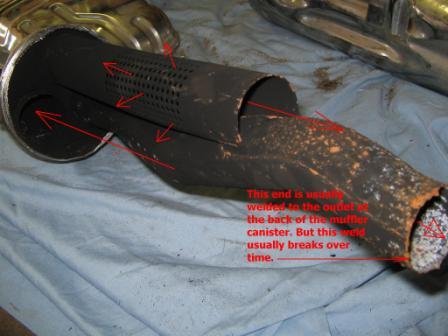ANDYVH
New member
I always wondered myself, because I am curious about exhaust tuning. The older Oilhead mufflers are known to develop a crack at the weld of the tube to the muffler canister when the bike gets some high miles on it.
When it develops the crack, the sound increases slightly and is actually kind of a better sound than stock. Some people drill out the end cap of the muffler to get some more sound, but in most cases unless you pump in more air and fuel you are not making any more power. It may be slightly better at high rpm, but not at low to mid-range. A Techlusion will help that though.
When my 94 R1100RS developed the crack, I had it TIG-welded to repair it. But I later found another failed one at my dealer and decided to do some research, sawzall wise. I cut the muffler canister off at the weld to the large bend on the CAT section of the exhaust. It cut off quite easily and clean. The attached photo shows the stock innards. The exhaust first comes out the perforated tube. It then resonates in the large volume of the canister (that's beneficial for both low noise and tuning for mid-to-high rpm power). Then the exhaust is directed into the opening at the CAT elbow, makes another 180 degree turn and finally exits through the long bent tube. That long tube is also benficial for quiet sound quality with a low tone frequency.
Once I figured that out, I designed my owm internals based on Flow-Master style mufflers. I got my own special sound and a stronger running bike. But the other design I have considered is a muffler in place of the current CAT, that exits below the bike like a Buell system, with no muffler canister at all to block the view of the rear wheel. Had BMW done that the saddlebags could have been larger capacity still.
When it develops the crack, the sound increases slightly and is actually kind of a better sound than stock. Some people drill out the end cap of the muffler to get some more sound, but in most cases unless you pump in more air and fuel you are not making any more power. It may be slightly better at high rpm, but not at low to mid-range. A Techlusion will help that though.
When my 94 R1100RS developed the crack, I had it TIG-welded to repair it. But I later found another failed one at my dealer and decided to do some research, sawzall wise. I cut the muffler canister off at the weld to the large bend on the CAT section of the exhaust. It cut off quite easily and clean. The attached photo shows the stock innards. The exhaust first comes out the perforated tube. It then resonates in the large volume of the canister (that's beneficial for both low noise and tuning for mid-to-high rpm power). Then the exhaust is directed into the opening at the CAT elbow, makes another 180 degree turn and finally exits through the long bent tube. That long tube is also benficial for quiet sound quality with a low tone frequency.
Once I figured that out, I designed my owm internals based on Flow-Master style mufflers. I got my own special sound and a stronger running bike. But the other design I have considered is a muffler in place of the current CAT, that exits below the bike like a Buell system, with no muffler canister at all to block the view of the rear wheel. Had BMW done that the saddlebags could have been larger capacity still.





